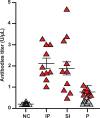Can sexual transmission support the enzootic cycle of Trypanosoma cruzi?
- PMID: 29211102
- PMCID: PMC5719536
- DOI: 10.1590/0074-02760170025
Can sexual transmission support the enzootic cycle of Trypanosoma cruzi?
Abstract
Background: Trypanosoma cruzi circulates in sylvatic habitats, mainly through blood-feeding triatomines, although other routes also contribute to its dispersion. Sexual transmission of T. cruzi is an understudied topic, especially among wild mammals. Because of the difficulties inherent to field work, experimentally infected mice are frequently used to evaluate the transmission of T. cruzi.
Objective: This study aimed to evaluate the sexual transmission of T. cruzi in acutely infected mice.
Methods: Male and female mice in the acute phase of Chagas disease were mated with naïve partners. Then, parasitological tests, immunohistochemistry, serological assays, and polymerase chain reaction (PCR) assays were used to detect infection.
Findings: Parasitological analysis showed trypomastigotes in the blood of 20% of the naïve mice after mating with infected partners. Serological assays detected anti-T. cruzi antibodies in all naïve females mated with infected males and in 60% of naïve males mated with infected females. PCR showed T. cruzi nDNA bands for all naïve mice mated with infected partners. The possibility of sexual transmission was also confirmed by visualisation of amastigotes in the testes.
Main conclusions: Our results demonstrate that sexual transmission of T. cruzi is an ordinary event that may contribute to maintenance of the parasite's enzootic cycle.
Figures






Similar articles
-
Sexual transmission of Trypanosoma cruzi in murine model.Exp Parasitol. 2016 Mar;162:1-6. doi: 10.1016/j.exppara.2015.12.017. Epub 2015 Dec 24. Exp Parasitol. 2016. PMID: 26724377
-
Sexual transmission of American trypanosomiasis in humans: a new potential pandemic route for Chagas parasites.Mem Inst Oswaldo Cruz. 2017 Jun;112(6):437-446. doi: 10.1590/0074-02760160538. Mem Inst Oswaldo Cruz. 2017. PMID: 28591404 Free PMC article.
-
Potential sexual transmission of Trypanosoma cruzi in mice.Acta Trop. 2015 Sep;149:15-8. doi: 10.1016/j.actatropica.2015.05.002. Epub 2015 May 14. Acta Trop. 2015. PMID: 25982870 Free PMC article.
-
American trypanosomiasis and Chagas disease: Sexual transmission.Int J Infect Dis. 2019 Apr;81:81-84. doi: 10.1016/j.ijid.2019.01.021. Epub 2019 Jan 18. Int J Infect Dis. 2019. PMID: 30664986 Review.
-
[Oral transmission of Trypanosoma cruzi : a new epidemiological scenario for Chagas' disease in Colombia and other South American countries].Biomedica. 2014 Oct-Dec;34(4):631-41. doi: 10.1590/S0120-41572014000400017. Biomedica. 2014. PMID: 25504253 Review. Spanish.
References
-
- Alencar AA, Brito CMM, Azevedo BA. Studies on the infectivity of semen from Trypanosoma cruzi-infected mice with destruction of neuronal structures. Rev Bras Neurol. 1991;27:51–56.
-
- Ashour HM, Seif TM. The role of B cells in the induction of peripheral T cell tolerance. J Leukoc Biol. 2007;82(5):1033–1039. - PubMed
-
- Carvalho LO, Abreu-Silva AL, Hardoim DJ, Tedesco RC, Mendes VG, da Costa SC, et al. Trypanosoma cruzi and myoid cells from seminiferous tubules: interaction and relation with fibrous components of extracellular matrix in experimental Chagas' disease. Int J Exp Pathol. 2009;90(1):52–57. - PMC - PubMed
-
- Coventry BJ, Bradley J, Skinner JM. Differences between standard and high-sensitivity immunohistology in tissue sections-comparison of immunoperoxidase staining methods using computerized video image analysis techniques. Pathology. 1995;27(3):221–223. - PubMed
MeSH terms
Substances
LinkOut - more resources
Full Text Sources
Other Literature Sources
Medical

